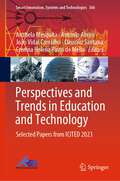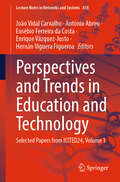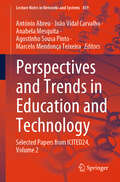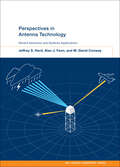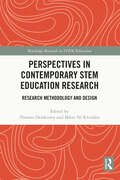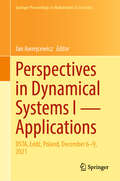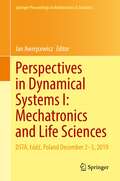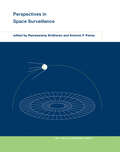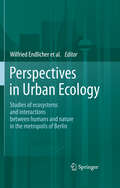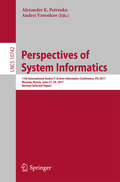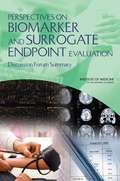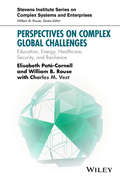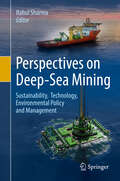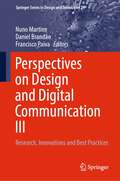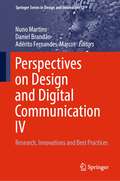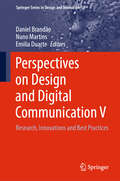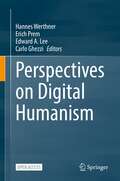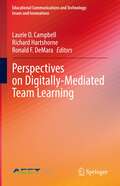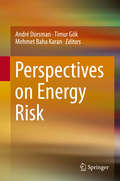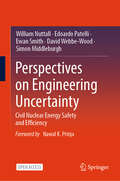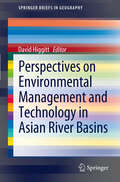- Table View
- List View
Perspectives and Trends in Education and Technology: Selected Papers from ICITED 2023 (Smart Innovation, Systems and Technologies #366)
by Anabela Mesquita António Abreu João Vidal Carvalho Cristina Helena Pinto de Mello Cleuciliz SantanaThis book presents high-quality, peer-reviewed papers from the International Conference in Information Technology & Education (ICITED 2023), to be held at the Nilton Lins University, Manaus, Brazil, during June 29–30, 2023. The book covers a specific field of knowledge. This intends to cover not only two fields of knowledge—Education and Technology—but also the interaction among them and the impact/result in the job market and organizations. It covers the research and pedagogic component of Education and Information Technologies but also the connection with Society, addressing the three pillars of higher education. The book addresses impact of pandemic on education and use of technology in education. Finally, it also encourages companies to present their professional cases which will be discussed. These can constitute real examples of how companies are overcoming their challenges with the uncertainty of the market.
Perspectives and Trends in Education and Technology: Selected Papers from ICITED24, Volume 1 (Lecture Notes in Networks and Systems #858)
by António Abreu João Vidal Carvalho Eusébio Ferreira da Costa Enrique Vázquez-Justo Hernán Viguera FigueroaThis book from the LNNS Series is composed of the best selected papers accepted for presentation and discussion at the 2024 International Conference in Information Technology & Education (ICITED’24). The ICITED is a multidisciplinary conference with a special focus on new Technologies and Systems in the Education sector and was held between July 11 and 13, 2024. The ICITED’24 was supported by the Pernambuco University, Recife, Brazil, and by IADITI—International Association for Digital Transformation and Technological Innovation. The International Conference in Information Technology & Education is an international forum for researchers and professionals in the education sector, which enables the discussion of the latest innovations, trends, and concerns in several areas, in the education sector, associated with information technologies and systems. It is an event for professionals in the sector, in search of technology solutions, where academics, IT experts, and business managers meet to discuss new ideas that help them maximize the potential of learning processes through technology. The ICITED’24 Scientific Committee is composed of a multidisciplinary group of 143 experts who assessed some 262 papers from 26 countries, received for each of the main topics proposed for the conference. The papers accepted for presentation and discussion at the conference are published by Springer and will be submitted for indexing by ISI, SCOPUS, EI-Compendex, Google Scholar, and SpringerLink.
Perspectives and Trends in Education and Technology: Selected Papers from ICITED24, Volume 2 (Lecture Notes in Networks and Systems #859)
by Anabela Mesquita António Abreu João Vidal Carvalho Agostinho Sousa Pinto Marcelo Mendonça TeixeiraThis book from the LNNS Series is composed of the best selected papers accepted for presentation and discussion at the 2024 International Conference in Information Technology & Education (ICITED’24). The ICITED is a multidisciplinary conference with a special focus on new Technologies and Systems in the Education sector and was held between July 11 and 13, 2024. The ICITED’24 was supported by the Pernambuco University, Recife, Brazil, and by IADITI—International Association for Digital Transformation and Technological Innovation. The International Conference in Information Technology & Education is an international forum for researchers and professionals in the education sector, which enables the discussion of the latest innovations, trends, and concerns in several areas, in the education sector, associated with information technologies and systems. It is an event for professionals in the sector, in search of technology solutions, where academics, IT experts, and business managers meet to discuss new ideas that help them maximize the potential of learning processes through technology. The ICITED’24 Scientific Committee is composed of a multidisciplinary group of 143 experts who assessed some 262 papers from 26 countries, received for each of the main topics proposed for the conference. The papers accepted for presentation and discussion at the conference are published by Springer and will be submitted for indexing by ISI, SCOPUS, EI-Compendex, Google Scholar, and SpringerLink.
Perspectives in Antenna Technology: Recent Advances and Systems Applications (MIT Lincoln Laboratory Series)
by Jeffrey S. Herd Alan J. Fenn M. David ConwayThe definitive volume of recent innovations in antenna technology developed for a wide variety of system applications at MIT Lincoln Laboratory.Antenna technology plays a key role in enabling next-generation sensing and communications for ground-based, airborne, and spaceborne systems across a wide spectrum of frequencies and applications. Advances in RF microelectronics, commercial high-volume manufacturing and packaging, high-fidelity modeling and simulation tools, and affordable high-speed digital signal processing offer new options for next-generation antenna systems. Perspectives in Antenna Technology, by Jeffrey S. Herd, Alan J. Fenn, and M. David Conway, describes a variety of antenna research and development projects from MIT Lincoln Laboratory over the past fifteen years. In addition to highlighting current systems applications for the new antenna technologies, the book provides a modern perspective on the evolution of antenna technology at MIT Lincoln Laboratory.The contributors to this book are all from MIT Lincoln Laboratory. The developments covered include those aimed at reducing the cost of phased array antennas by leveraging high-volume printed circuit board manufacturing and highly integrated packaging techniques; novel solutions to enable ultra-lightweight deployable antennas for space and airborne applications; vector sensor arrays; two unique imaging radar systems, a video-rate microwave imaging system for person-borne concealed threat detection and a system capable of ultrawideband imaging of satellites; simultaneous transmit and receive (STAR) antennas; a variety of novel wideband array antennas, including dual-polarized stepped-notch arrays and coupled dipole arrays; and several types of custom millimeter wave (mmWave) antennas.
Perspectives in Contemporary STEM Education Research: Research Methodology and Design (Routledge Research in STEM Education)
by Thomas Delahunty Máire Ní RíordáinThis book presents an overview of the methodological innovations and developments present in the field of STEM education research as well as providing a practically orientated resource on research method design more broadly. Featuring a range of international contributors in the field, the book provides a compendium of exemplary innovative methodological designs, implementations, and analyses that answer a variety of research questions relating to STEM education disciplines. Charting the thinking behind the design and implementation of successful research investigations, the book’s two parts present an accessible and pragmatically framed set of chapters that cover a range of important methodological areas presented by active researchers in the field. Ultimately, this book presents a comprehensive resource that explores the act of educational research as related to STEM. By showcasing key methodological principles with guidance on practical approaches underpinned by theory, the book offers scholarly research-informed suggestions for practice. It will be of great interest to researchers, academics, and students in the fields of STEM education and education research methods, as well as educational research more broadly.
Perspectives in Dynamical Systems I — Applications: DSTA, Łódź, Poland, December 6–9, 2021 (Springer Proceedings in Mathematics & Statistics #453)
by Jan AwrejcewiczThis proceedings volume gathers selected, peer-reviewed papers presented at the Dynamical Systems Theory and Applications International Conference - DSTA 2021, held virtually on December 6-9, 2021, organized by the Department of Automation, Biomechanics, and Mechatronics at Lodz University of Technology, Poland. This volume concentrates on studies on applications, while Volume II focuses on numerical and analytical approaches.Being a truly international conference, this 16th iteration of DSTA received submissions from authors representing 52 countries. The program covered both theoretical and experimental approaches to widely understood dynamical systems, including topics devoted to bifurcations and chaos, control in dynamical systems, asymptotic methods in nonlinear dynamics, stability of dynamical systems, lumped mass and continuous systems vibrations, original numerical methods of vibration analysis, nonsmooth systems, dynamics in life sciences and bioengineering, as well as engineering systems and differential equations.DSTA conferences aim to provide a common platform for exchanging new ideas and results of recent research in scientific and technological advances in modern dynamical systems. Works contained in this volume can appeal to researchers in the field, whether in mathematics or applied sciences, and practitioners in myriad industries.
Perspectives in Dynamical Systems I: DSTA, Łódź, Poland December 2–5, 2019 (Springer Proceedings in Mathematics & Statistics #362)
by Jan AwrejcewiczThis volume is part of collection of contributions devoted to analytical and experimental techniques of dynamical systems, presented at the 15th International Conference “Dynamical Systems: Theory and Applications”, held in Łódź, Poland on December 2-5, 2019. The wide selection of material has been divided into three volumes, each focusing on a different field of applications of dynamical systems.The broadly outlined focus of both the conference and these books includes bifurcations and chaos in dynamical systems, asymptotic methods in nonlinear dynamics, dynamics in life sciences and bioengineering, original numerical methods of vibration analysis, control in dynamical systems, optimization problems in applied sciences, stability of dynamical systems, experimental and industrial studies, vibrations of lumped and continuous systems, non-smooth systems, engineering systems and differential equations, mathematical approaches to dynamical systems, and mechatronics.
Perspectives in Space Surveillance (MIT Lincoln Laboratory Series)
by Ramaswamy Sridharan Antonio PensaThe development of deep space surveillance technology and its later application to near-Earth surveillance, covering work at Lincoln Laboratory from 1970 to 2000.In the 1950s, the United States and the Soviet Union raced to develop space-based intelligence gathering capability. The Soviets succeeded first, with SPUTNIK I in 1957. The United States began to monitor the growing Soviet space presence by developing technology for the detection and tracking of man-made resident space objects (RSOs) in near-Earth orbit. In 1972, the Soviet Union launched a satellite into deep space orbit, and the U.S. government called on MIT Lincoln Laboratory to develop deep space surveillance technology. This book describes these developments, as well as the later application of deep space surveillance technology to near-Earth surveillance, covering work at Lincoln Laboratory on space surveillance from 1970 to 2000.The contributors, all key participants in developing these technologies, discuss topics that include narrow beam, narrow bandwidth radar for deep surveillance; wide bandwidth radar for RSO monitoring; ground-based electro-optical deep space surveillance and its adaptation for space-based surveillance; radar as the means of real-time search and discovery techniques; methods of analyses of signature data from narrow bandwidth radars; and the collision hazard for satellites in geosynchronous orbit, stemming initially from the failure of TELSTAR 401. They also describe some unintended byproducts of this pioneering work, including the use of optical space surveillance techniques for near-Earth asteroid detection. ContributorsRick Abbott, Robert Bergemann, E.M. Gaposchkin, Israel Kupiec, Richard Lambour, Antonio F. Pensa, Eugene Rork, Jayant Sharma, Craig Solodyna, Ramaswamy Sridharan, J. Scott Stuart, George Zollinger
Perspectives in Sustainable Nematode Management Through Pochonia chlamydosporia Applications for Root and Rhizosphere Health
by Rosa H. Manzanilla-López Luis V. Lopez-LlorcaThis volume reviews our current knowledge and novel research areas on Pochonia chlamydosporia, a cosmopolitan fungus occurring in soils as a saprophyte yet capable of colonizing the rhizosphere of crops as an endophyte and behaving as a parasite of eggs of plant-parasitic nematodes. The book is divided into six sections containing 18 chapters, starting with a historical background chapter, followed by 16 chapters, each contributed by experts, concerning those key aspects necessary to work with this biocontrol agent in a multidisciplinary treatise. Topics covered include systematics, biology, nematode-fungus interactions, nematode management strategies, secondary metabolites, and other methods including more novel research areas such as molecular, –omics, plant growth enhancement and endophytic abilities of P. chlamydosporia. The final chapter deals with the future perspectives of P. chlamydosporia research.
Perspectives in Urban Ecology
by Wilfried EndlicherThis book gives an interdisciplinary overview on urban ecology. Basic understanding of urban nature development and its social reception are discussed for the European Metropolitan Area of Berlin. Furthermore, we investigate specific consequences for the environment, nature and the quality of life for city dwellers due to profound changes such as climate change and the demographic and economic developments associated with the phenomena of shrinking cities. Actual problems of urban ecology should be discussed not only in terms of natural dimensions such as atmosphere, biosphere, pedosphere and hydrosphere but also in terms of social and cultural dimensions such as urban planning, residence and recreation, traffic and mobility and economic values. Our research findings focus on streets, new urban landscapes, intermediate use of brown fields and the relationships between urban nature and the well-being of city dwellers. Finally, the book provides a contribution to the international discussion on urban ecology.
Perspectives of System Informatics
by Andrei Voronkov Alexander K. PetrenkoThis book constitutes the thoroughly refereed post-conference proceedings of the 6th International Andrei Ershov Memorial Conference, PSI 2006, held in Akademgorodok, Novosibirsk, Russia in June 2006. The 30 revised full papers and 10 revised short papers presented together with 5 invited papers address all current aspects of theoretical computer science, programming methodology, and new information technologies.
Perspectives on Biomarker and Surrogate Endpoint Evaluation: Discussion Forum Summary
by Institute of Medicine of the National AcademiesIn 2010 the Institute of Medicine (IOM) recommended a framework for the evaluation of biomarkers in the chronic disease setting. Published in the book Evaluation of Biomarkers and Surrogate Endpoints in Chronic Disease, the framework is intended to bring consistency and transparency to the previously disparate process of biomarker evaluation. Following the book's release, the IOM convened a 2-day discussion forum in Washington, DC, in order to provide an opportunity for stakeholders to learn about, react to, and discuss the book. Presentations reviewed the authoring committee's work process, recommendations, and provided perspectives on the book from the point of view of participants. Thomas Fleming, professor of biostatistics and statistics at the University of Washington, gave a keynote presentation on the critical issues in the validation of surrogate endpoints, a specific use of a biomarker. The present volume recounts the discussion forum proceedings, focusing in turn on each represented sector. A summary of Dr. Fleming's presentation then sets the committee's recommendations within the context of biomarker utilization. Lastly, this summary examines the main themes raised by stakeholders, and the challenges and opportunities presented to stakeholders by the book's recommendations.
Perspectives on Classification in Synthetic Sciences: Unnatural Kinds (History and Philosophy of Technoscience)
by Julia R. S. BurstenThis volume launches a new series of contemporary conversations about scientific classification. Most philosophical conversations about kinds have focused centrally or solely on natural kinds, that is, kinds whose existence is not dependent on the scientific process of synthesis. This volume refocuses conversations about classification on unnatural, or synthetic, kinds via extensive study of three paradigm cases of unnatural kinds: nanomaterials, stem cells, and synthetic biology.
Perspectives on Complex Global Challenges: Education, Energy, Healthcare, Security, and Resilience
by Charles M. Vest William B. Rouse Elisabeth Pate-CornellExamines current and prospective challenges surrounding global challenges of education, energy, healthcare, security, and resilience This book discusses issues in large-scale systems in the United States and around the world. The authors examine the challenges of education, energy, healthcare, national security, and urban resilience. The book covers challenges in education including America's use of educational funds, standardized testing, and the use of classroom technology. On the topic of energy, this book examines debates on climate, the current and future developments of the nuclear power industry, the benefits and cost decline of natural gases, and the promise of renewable energy. The authors also discuss national security, focusing on the issues of nuclear weapons, terrorism and cyber security. Urban resilience is addressed in the context of natural threats such as hurricanes and floods. Studies the usage of a globalized benchmark for both student and pedagogical performance Covers topics such as surveillance, operational capabilities, movement of resources, and the pros and cons of globalization Examines big data, evolving medical methodologies and effects on the medical educational curriculum, and the positive effects of electronic records in healthcare data Perspectives on Complex Global Challenges: Education, Energy Healthcare, Security, and Resilience serves as a reference for government officials, personnel in security, business executives and system engineers.
Perspectives on Deep-Sea Mining: Sustainability, Technology, Environmental Policy and Management
by Rahul SharmaThis book is a sequel to ’Deep-Sea Mining: Resource Potential, Technical and Environmental Considerations’ (2017) and ‘Environmental Issues of Deep-Sea Mining: Impacts, Consequences and Policy Perspectives’ (2019), and aims to provide a comprehensive volume on different perspectives of deep-sea mining from specialists around the world. The work is timely, as deep-sea minerals continue to enthuse researchers involved in activities such as ascertaining their potential as alternative sources for critical metals for green energy and other industrial applications, as well as technology development for their sustainable exploration and exploitation, while addressing environmental concerns. With a steady increase in the number of contractors having exclusive rights over large tracts of seafloor in the ‘Area’, i.e. area beyond national jurisdictions, the International Seabed Authority, mandated with the responsibility of regulating such activities, is in the process of developing a code for exploitation of deep-sea minerals. These, coupled with growing interest among private entrepreneurs, investment companies and policy makers, underscore the need for updated information to be made available in one place on the subject of deep-sea mining. The book evaluates the potential and sustainability of mining for deep-sea minerals compared to other land-based deposits, the technologies needed for mining and processing of ores, the approach towards environmental monitoring and management, as well as the regulatory frameworks and legal challenges to manage deep-sea mining activities. The book is expected to serve as an important reference for all stakeholders including researchers, contractors, mining companies, regulators and NGOs involved in deep-sea mining.
Perspectives on Design Education in India and Asia
by Venkatesh Rajamanickam Ravi Poovaiah Peer M. Sathikh Karin G. OenThis book spotlights design and media education in Asia, with contributors providing their reflections on curriculum development, pedagogy, and practice from Australia, China, Japan, India, Mongolia, the Philippines, Singapore, and Turkey.The chapters provide in-depth and specific examples of how curricula and educational resources have been organised with respect to a wide variety of subjects, including aesthetics, engineering, and practice-based coursework. These course plans have also been adapted to respond to questions about integrating emerging technologies in the classroom and addressing changing industry needs as well as the need to encourage resilience and leadership skills across student and faculty cohorts. Although not an analysis of educational and industrial policies, some key documents such as The India Design Report of 1958 by Charles and Ray Eames and India’s National Education Policy of 2020 are referenced to provide important background information for understanding the past, present, and future of the design education ecosystem across the region.Presenting both historical context and practical contemporary applications of curricula in specific universities and design schools, this volume is compiled to share resources among faculty and researchers interested in global Asian design pedagogy who have previously relied upon publications centred on the UK and US contexts. It will appeal to design educators and anyone responsible for design education curricula across the Asian region and beyond.
Perspectives on Design and Digital Communication III: Research, Innovations and Best Practices (Springer Series in Design and Innovation #24)
by Francisco Paiva Nuno Martins Daniel BrandãoThis book gathers new empirical findings fostering advances in the areas of digital and communication design, web, multimedia and motion design, graphic design, branding, and related ones. It includes original contributions by authoritative authors based on the best papers presented at the 5th International Conference on Digital Design and Communication, Digicom 2021, together with some invited chapters written by leading international researchers. They report on innovative design strategies supporting communication in a global, digital world, and addressing, at the same time, key individual and societal needs. This book is intended to offer a timely snapshot of technologies, trends and challenges in the area of design, communication and branding, and a bridge connecting researchers and professionals of different disciplines, such as graphic design, digital communication, corporate, UI Design and UX design.
Perspectives on Design and Digital Communication IV: Research, Innovations and Best Practices (Springer Series in Design and Innovation #33)
by Nuno Martins Daniel Brandão Adérito Fernandes-MarcosThis book gathers new empirical findings fostering advances in the areas of digital and communication design, web, multimedia and motion design, graphic design, branding, and related ones. It includes original contributions by authoritative authors based on the best papers presented at the 6th International Conference on Digital Design and Communication, Digicom 2022, together with some invited chapters written by leading international researchers. They report on innovative design strategies supporting communication in a global, digital world, and addressing, at the same time, key individual and societal needs. This book is intended to offer a timely snapshot of technologies, trends and challenges in the area of design, communication and branding, and a bridge connecting researchers and professionals of different disciplines, such as graphic design, digital communication, corporate, UI Design and UX design.
Perspectives on Design and Digital Communication V: Research, Innovations and Best Practices (Springer Series in Design and Innovation #50)
by Nuno Martins Daniel Brandão Emilia DuarteThis book gathers new empirical findings fostering advances in the areas of digital and communication design, web, multimedia and motion design, graphic design, branding, and related ones. It includes original contributions by authoritative authors based on the best papers presented at the 7th International Conference on Digital Design and Communication, Digicom 2023, together with some invited chapters written by leading international researchers. They report on innovative design strategies supporting communication in a global, digital world, and addressing, at the same time, key individual and societal needs. This book is intended to offer a timely snapshot of technologies, trends and challenges in the area of design, communication and branding, and a bridge connecting researchers and professionals of different disciplines, such as graphic design, digital communication, corporate, UI Design and UX design.
Perspectives on Digital Humanism
by Hannes Werthner Carlo Ghezzi Edward A. Lee Erich PremThis open access book aims to set an agenda for research and action in the field of Digital Humanism through short essays written by selected thinkers from a variety of disciplines, including computer science, philosophy, education, law, economics, history, anthropology, political science, and sociology. This initiative emerged from the Vienna Manifesto on Digital Humanism and the associated lecture series. Digital Humanism deals with the complex relationships between people and machines in digital times. It acknowledges the potential of information technology. At the same time, it points to societal threats such as privacy violations and ethical concerns around artificial intelligence, automation and loss of jobs, ongoing monopolization on the Web, and sovereignty. Digital Humanism aims to address these topics with a sense of urgency but with a constructive mindset. The book argues for a Digital Humanism that analyses and, most importantly, influences the complex interplay of technology and humankind toward a better society and life while fully respecting universal human rights. It is a call to shaping technologies in accordance with human values and needs.
Perspectives on Digitally-Mediated Team Learning (Educational Communications and Technology: Issues and Innovations)
by Laurie O. Campbell Richard Hartshorne Ronald F. DeMaraThis book explores technology-supported andragogical and pedagogical approaches that facilitate teamwork, collaboration, communication, and problem-solving opportunities in diverse disciplines. Collaboration and communication skills are not typically developed in traditional STEM instructional practices.The purpose of the book includes expanding the learning science research base regarding how learning principles and strategies, including structured, collaborative, active, contextual, and engaging instructional settings, can support foundational STEM instruction and improve student interest and achievement. The chapters are classified into three categories: (a) empirical studies exploring the manner in which technology-enabled pedagogical principles and practices facilitate student interest in STEM courses, (b) exploration of logistical factors associated with revisioning STEM education and (c) theoretical underpinnings and literature review of digitally-mediated team learning. The book showcases full-length manuscripts advancing transformative approaches for technology-enhanced team learning within STEM disciplines. Contributions have been sought from interdisciplinary researchers, developers, and educators who engage in the research, development, and practice of adaptable digital environments for highly-effective, rewarding, and scalable team-based and collaborative learning. These include such topics as real-time tools for teams in classroom settings; learning analytics; effective technology-enabled pedagogies; and technology-enabled, collaborative, pedagogical approaches to broaden participation in STEM disciplines. Promising approaches and technologies to advance digitally-mediated team and collaborative learning are explored including learning analytics to form effective learning teams. Further, innovative cyber-assisted observation approaches for diagnostic/assessment observation and interaction with student teams, educational data mining of large volumes of collected data, and leveraging. The book will be of interest to Higher Education Faculty in STEM, Learning Scientist, and K-12 educators and learning coaches.
Perspectives on Earthquake Geotechnical Engineering
by Atilla Ansal Mohamed SakrThis book offers a broad perspective on important topics in earthquake geotechnical engineering and gives specialists and those that are involved with research and application a more comprehensive understanding about the various topics. Consisting of eighteen chapters written by authors from the most seismic active regions of the world, such as USA, Japan, Canada, Chile, Italy, Greece, Portugal, Taiwan, and Turkey, the book reflects different views concerning how to assess and minimize earthquake damage. The authors, a prominent group of specialists in the field of earthquake geotechnical engineering, are the invited lecturers of the International Conference on Earthquake Geotechnical Engineering from Case History to Practice in the honour of Professor Kenji Ishihara held in Istanbul, Turkey during 17-19 June 2013.
Perspectives on Energy Risk
by André Dorsman Mehmet Baha Karan Timur GökSince the Industrial Revolution, the efficiency with which energy resources are extracted and converted into work has played a prominent role in the accumulation of material wealth The prominent role of energy resources, in conjunction with their scarcity and their uneven geographic distribution, has had significant repercussions. Collaboration, competition and conflict among nation states for energy resources have created global, geopolitical and market risks. In this volume, academic scholars and practitioners assess these risks from global, geopolitical and market perspectives. They do so by presenting empirical research and discussing our current understanding of this quickly changing and developing field. This is the third volume in a series on energy organized by the Centre for Energy and Value Issues (CEVI). The previous volumes in the series were Financial Aspects in Energy (2011) and Energy Economics and Financial Markets (2012).
Perspectives on Engineering Uncertainty: Civil Nuclear Energy Safety and Efficiency
by Edoardo Patelli William Nuttall Ewan Smith David Webbe-Wood Simon MiddleburghThis open access book considers the role of uncertainty in the design and development of large-scale engineering systems. The focus of the book is the safe behaviour of nuclear power plants in both routine operations and in incident situations. The book introduces various types of uncertainty and addresses the extent to which uncertainties may be reduced. The role of multiple dimensions of uncertainty is discussed, as is the importance of modern computational techniques in handling large data sets. Modern IT also provides engineers with new tools, such as digital twins with the potential to greatly reduce cost both in design and in operations. The book focuses on both system safety and efficiency and, to do this, reference is made to the Advanced Gas-Cooled Reactor (AGR). The AGR is a mature established system through which the book elucidates various key concepts and ideas. As well as being of interest to those working in the nuclear industry, the book is likely to appeal to those working in other safety critical engineering sectors and, for example, reference is made to experiences in aviation and railway engineering. This is neither a text book nor a review, it is a primer for those seeking an introduction to modern approaches to uncertainty.
Perspectives on Environmental Management and Technology in Asian River Basins
by David HiggittAsian river basins are undergoing rapid transformation. This volume considers the implications of the environmental change-development nexus for water management, river health and hazard awareness. As Biswas and Tortajada (2011) have recently commented, water management in Asia will likely change more in the next twenty years than in the last 2000 years. Critical environmental trends include decreasing flows of water and sediment due to dam construction and increased water extraction, land use change (especially forest removal), encroachment and degradation of floodplain and wetland environments, increased water demand and concerns about water security, urban expansion and associated pollution of rivers and contamination of groundwater reserves. These challenges are being reframed by new approaches to water management which represent a transition from engineering-dominated approaches towards integrated water management, from technology transfer to adaptive technologies. The volume comprises an introduction and five chapters. Brierley and Callum reframe approaches to river repair within emerging theories of in ecology and earth science which regard nature as a complex adaptive system replete with inherent uncertainties. These ideas are mirrored in the four case study chapters which deal with water governance in the Mekong Basin (Hirsch); hybrid adoption of water resource technologies in India (Barbanente et al.); determination of sediment dynamics in Java Rijsdijk); and ecological conservation imperatives in the headwaters of the Yellow, Yangtze and Mekong rivers in western China (Li et al.).
